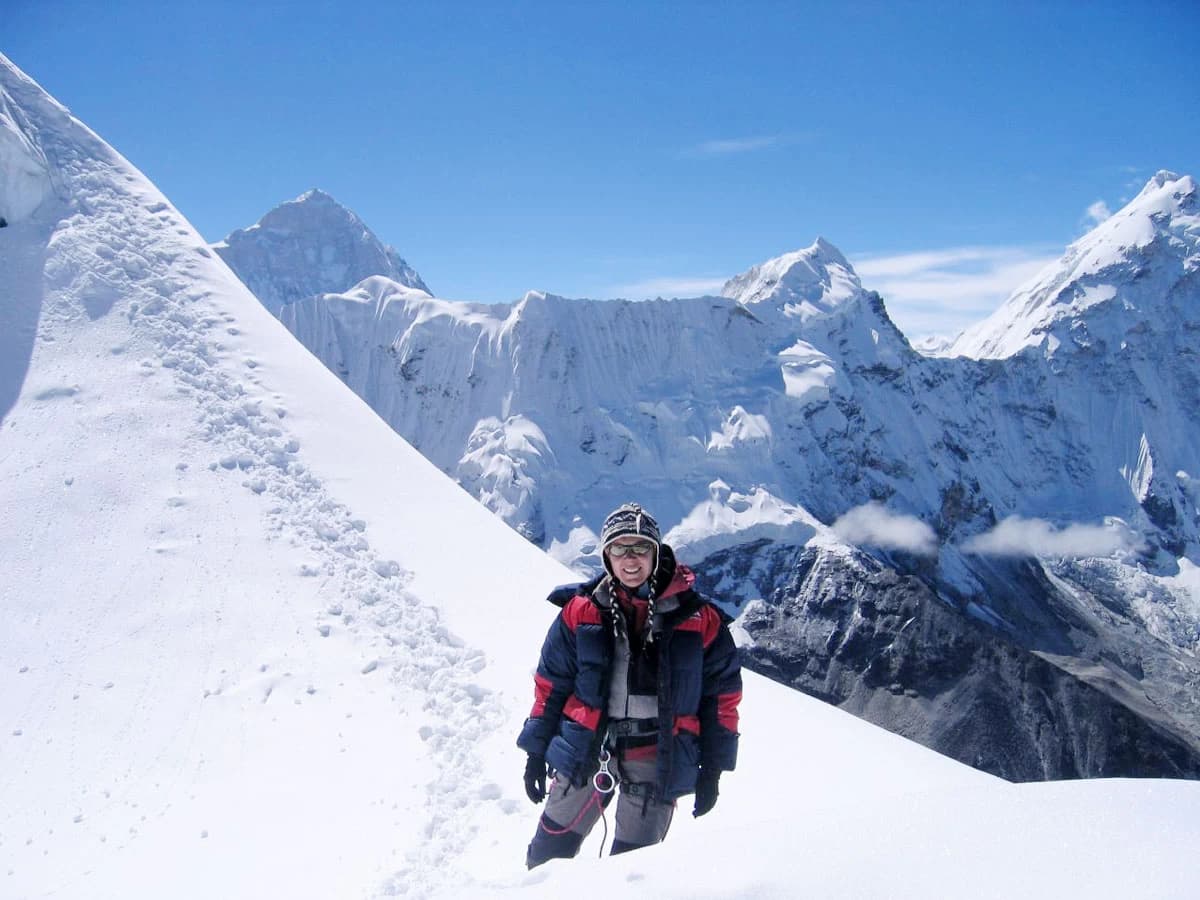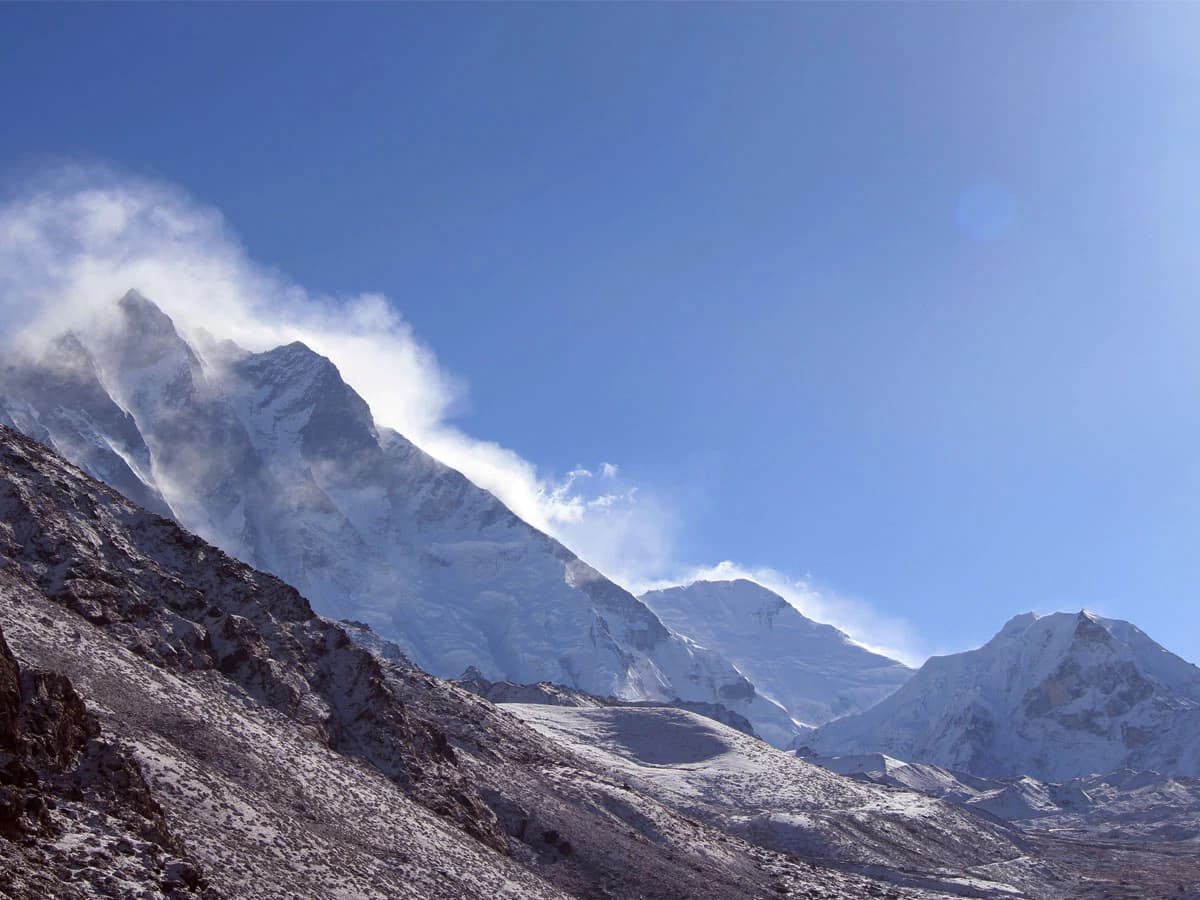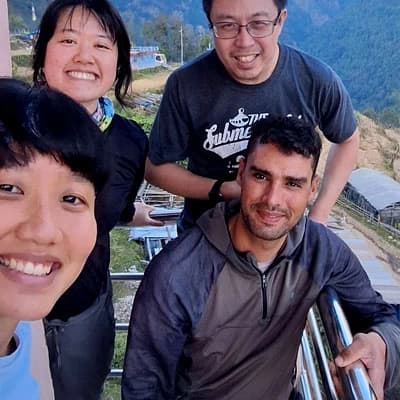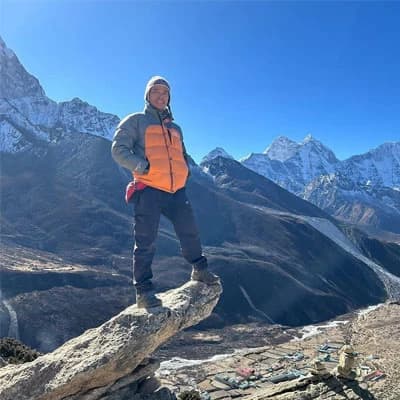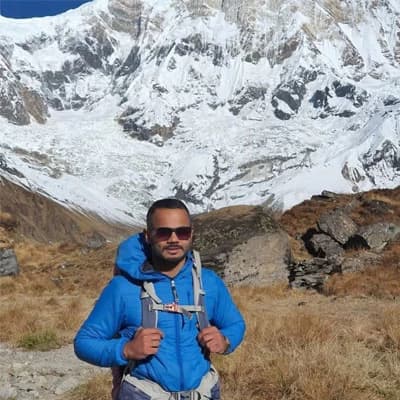Island Peak (6,189m/20,305 ft), locally known as Imja Tse, is a popular climbing destination for those seeking a thrilling yet accessible adventure in the Himalayas. It offers stunning views of nearby peaks like Lhotse, Makalu, Nuptse, and Ama Dablam. The climb serves as a perfect introduction for aspiring mountaineers, giving you a chance to gain experience before attempting higher peaks like Mount Everest. Additionally, the journey combines trekking and mountaineering, making it a rewarding adventure for climbers of various skill levels.
Island Peak Climbing
Highlights
- Reach the summit of Island Peak (6,189m) and enjoy breathtaking views of towering peaks.
- Witness close-up views of Lhotse, Nuptse, Ama Dablam, and many other famous mountains.
- Experience a night climb and watch the sunrise from the summit of Island Peak.
- Train with professional climbing gear like crampons and karabiners during a practice session at base camp.
- Camp at Island Peak Base Camp and enjoy a real mountain expedition experience.
- Trek through Sagarmatha National Park, home to rare wildlife and unique Himalayan flora.
- Visit Tengboche Monastery, the largest monastery in the Everest region.
- Explore traditional Sherpa villages and experience their warm hospitality and rich Buddhist culture.
- Walk past the Imja Glacier and surrounding ice formations, adding a true alpine feel to the adventure.
Trip Overview
Island Peak Climbing is an exciting adventure that offers stunning views of the Himalayas, including Mount Everest. The journey begins in Kathmandu, where you will enjoy a comfortable stay in a 3-star hotel. After that, you'll trek through enchanting villages and scenic landscapes, staying in cozy teahouses along the way. These teahouses provide basic but comfortable accommodations, and meals are served in a communal setting where you can meet other trekkers.
As you continue on your trek, you’ll climb toward the Island Peak Base Camp, where you'll experience the thrill of staying in a tented camp. Here, our team will prepare you for the final push to the summit, providing climbing gear and essential training. The climb itself is challenging, with steep sections requiring the use of ropes and tools like crampons and ice axes. The summit, at 6,189 meters, will be a tough but rewarding achievement.
Furthermore, acclimatization is very important to avoid altitude sickness. The higher you go, the thinner the air gets, making it harder to breathe. It's important to take it slow, drink plenty of water, and follow the advice of your guides. Throughout your trek, you'll have the chance to enjoy healthy meals, such as traditional Nepalese dishes like Dal Bhat, and tasty snacks like momo (dumplings). Staying well-fed and hydrated will help you stay strong for the climb.
Plus, the right equipment for the climb is crucial. You'll need warm clothing for the cold weather, along with gear for climbing, like helmets, harnesses, and crampons. You don’t need to worry if you don't have all the gear, as many items can be rented in Nepal. Our team will also provide you with a detailed packing list to make sure you're well-prepared.
Overall, Island Peak Climbing is a memorable adventure for those looking for a challenge. Whether you're a beginner or an experienced trekker, this climb offers an opportunity to push your limits while enjoying the beautiful Nepalese landscapes. With good preparation, proper gear, and the support of our expert guides, you'll be able to safely reach the summit and enjoy awe-inspiring views of the glorious peaks.
Island Peak Climbing Itinerary
Upon arrival at Tribhuvan International Airport in Nepal, a representative from Himalayan Massif Trek will meet you and transfer you to your hotel in Kathmandu. If you're already in Nepal, we can arrange a pick-up from your current hotel for the orientation session.
Our team will provide a briefing about the entire trip and go over the equipment and gear you'll need. Afterward, you’ll have the rest of the day to relax, explore Kathmandu, or shop for any additional items you may need.
You’ll have an early morning start with a short flight to Lukla (either from Kathmandu or Ramechhap). After a scenic 40-minute flight, you’ll meet the rest of our crew and porters in Lukla, who will handle your baggage. Then, you’ll trek for about 3-4 hours along the beautiful Dudh Koshi River to reach Phakding.
Note: During peak season, flight congestion may require you to fly from Ramechhap instead of Kathmandu. Outside peak seasons, a direct flight from Kathmandu to Lukla is typically available.
On your third day of the trek, you’ll experience the true beauty of the Everest region. You’ll wake up to a stunning sunrise, surrounded by peaceful scenery and fresh mountain air. After a satisfying breakfast, you’ll begin your trek towards Namche Bazaar.
The trek takes 5 to 6 hours, passing along the Dudh Koshi River with a few uphill and downhill sections, and through the villages of Monjo and Jorsalle. By late afternoon, you’ll reach Namche Bazaar. This vibrant town offers plenty of restaurants, internet cafes, pubs, a post office, as well as ATMs and banks.
Today is your acclimatization day in Namche Bazaar, allowing your body to adjust to the higher altitude before heading further up. You can take a relaxing side trip to the Everest View Hotel for amazing views of Mount Everest or explore the nearby villages of Khumjung and Kunde. These villages are home to the famous Edmund Hillary School and Khumjung Monastery, which houses the skull of the Yeti.
You could also visit the Sagarmatha National Park Visitor Center, learn more about the region’s history, or simply enjoy the peaceful surroundings. After a day of exploring, you’ll return to your lodge and enjoy a warm dinner to rest up for the next day’s journey.
On this day, you’ll trek along a beautiful trail with views of Mount Everest, Lhotse, Nuptse, and Ama Dablam. The route takes you around the side of the valley, and you’ll descend about 300 meters to cross the Dudh Koshi River, passing through several villages along the way. You’ll enjoy the peaceful surroundings of pine forests and stone walls as you continue your journey.
As you approach Tengboche, you’ll face a steep climb of 700 meters to reach the village, but the stunning views of the mountains make it worthwhile. Once in Tengboche, you can visit the famous Tengboche Monastery. If you arrive in time, you may witness the evening prayers and explore the beautiful artwork inside the monastery.
On Day 6, you’ll continue your trek through peaceful forests of juniper, pine, and birch. Along the way, enjoy stunning mountain views and cross the Imja River. You'll stop at the ancient Pangboche Monastery in the village of Pangboche before continuing your journey through the beautiful Imja Valley.
The path leads you along the Lobuche River, and after descending the river, you’ll climb up to Dingboche. This village is known for its stone walls surrounding fields of barley, buckwheat, and potatoes. You’ll be welcomed by the sight of these fields, adding a rural charm to your arrival.
Today is another acclimatization day at Dingboche. After breakfast, you’ll take a short but steep hike to Nagarjun Hill, reaching an elevation of about 4,900 meters. From the top, you’ll be rewarded with glorious views of towering peaks like Makalu, Cho Oyu, and Lhotse. After spending some time enjoying the scenery, you’ll descend back to Dingboche.
The rest of the day is yours to relax. You can take a leisurely walk around the village, explore the surrounding landscapes, or simply rest at your lodge. This is a great time to enjoy a warm meal, catch up with fellow trekkers, or prepare for the next day's adventure.
On Day 8, you’ll leave the classic Everest Base Camp trail and head toward Chhukhung Valley. The trek begins with a gentle walk into the Imja Valley, offering clear views of Lhotse and Ama Dablam. As you continue, the landscape opens up, revealing rugged cliffs and snow-covered peaks.
After passing through Bibre, a small yak herders' camp, you’ll trek for another 30 minutes to reach Chhukhung. This peaceful village is surrounded by towering mountains, making it a perfect place to rest and soak in the beauty of the region.
Today, you’ll leave Chhukhung and make your way toward Island Peak Base Camp. The trail takes you across rocky glacial moraines, with a mix of gentle and steep sections. After about five hours of trekking, you’ll arrive at the base camp, where you’ll settle into your tent for the night.
Once at camp, you’ll prepare for the climb ahead. Your climbing team will check your gear, including harnesses, crampons, and ropes, to ensure everything is ready. While the porters set up the tents, you’ll attend a short training session to practice using the equipment and climbing techniques. After the session, you can relax and have dinner before resting for the night.
Finally, the big day has arrived. Today, you’ll climb Island Peak - the moment you’ve been preparing for. You’ll leave your belongings at base camp and carry only a daypack with essentials like water, a packed lunch, a camera, and some energy bars or chocolate. The climb begins early in the morning, with a headlamp to guide your way in the dark.
The trail starts with a rocky section before leading to a steep, snowy slope. As you climb higher, the air gets thinner, making each step more challenging. But with determination and support from the climbing team, you’ll push through the final section using fixed ropes to reach the summit.
Reaching the top is a moment to celebrate. From here, you’ll see breathtaking views of Lhotse, Nuptse, and Ama Dablam towering around you. After taking in the incredible scenery, you’ll carefully descend back to base camp. Following a short rest, you’ll continue your trek down to Chhukhung, where a well-earned meal and a good night’s rest await.
Sometimes, the weather in the mountains can be unpredictable. If bad weather or other challenges prevent you from reaching the summit on Day 10, this extra day gives you another chance to make the climb. Having this flexibility increases your chances of a successful summit.
If you already reached the top on Day 10, you can use this day to explore more of the Everest region. You might take a short trek to nearby viewpoints or visit local villages. If you prefer, you can also start your descent early, making your journey back to Lukla more relaxed before your flight to Kathmandu.
After a good breakfast, you’ll begin your walk back down the trail. As you trek, you’ll cross small streams and pass by yak pastures. You’ll also walk through a small village called Dusum, where you can stop for a short break to rest and take in the scenery.
Once you arrive in Dingboche, you’ll relax in a comfortable teahouse, enjoy a warm meal, and unwind after the day’s trek.
On Day 13, you’ll start your journey back to Namche. While the descent may feel easier than the climb, it still requires focus and steady pacing to avoid straining your knees.
As you walk through the forest, you may spot some interesting wildlife, such as pheasants, musk deer, and martens. Once you arrive in Namche, you can relax and enjoy a warm cup of tea while soaking in the beautiful sunset, reflecting on your journey.
On your final trek, you’ll make your way from Namche to Lukla, covering a distance of about 17.9 kilometers. The walk is mostly downhill, making it a gentler end to your adventure. The trail takes you through green forests and across a fun suspension bridge over the Dudh Koshi River.
As you continue your journey, the mild ups and downs will feel easier after the challenging treks behind you. By the time you arrive in Lukla, you’ll likely have some time to relax with a snack before settling into your teahouse. Once you reach Lukla, your trek in the Everest region will come to a close, and you'll have a chance to reflect on the amazing memories you've created before heading back to Kathmandu.
Today, you'll take an early morning flight from Lukla to Kathmandu, as the weather can change quickly. As you fly, you'll get one last look at the stunning Everest region, with the mountains glowing in the soft morning light.
After landing in Kathmandu, you can relax with a refreshing shower. Then, take a leisurely walk through the vibrant streets of Thamel, a perfect spot to do some last-minute shopping for souvenirs before you head home.
This day is set aside as a leisure day in case of any flight delays from Lukla due to bad weather. If you’ve already arrived in Kathmandu and the weather is clear, you can spend your time exploring the city’s rich culture and history.
Kathmandu is home to many ancient sites, and you can choose to visit some of its famous landmarks.
You can explore seven UNESCO World Heritage sites, such as the Buddhist stupas of Swayambhu and Bauddhanath, and the Hindu temples of Pashupati and Changu Narayan. Don’t miss the beautiful Durbar Squares in Kathmandu, Patan, and Bhaktapur, which are filled with history and stunning architecture.
Today marks the end of your adventure in Nepal. Our team will take you to the airport about 3 hours before your scheduled flight. Before leaving, make sure you have all your travel documents ready for your journey home.
We hope you had an amazing time trekking with Himalayan Massif Trek. If you ever want to explore more of Nepal or plan another adventure, feel free to reach out. We would be happy to help you plan your next trip.
Island Peak Climbing Route Map
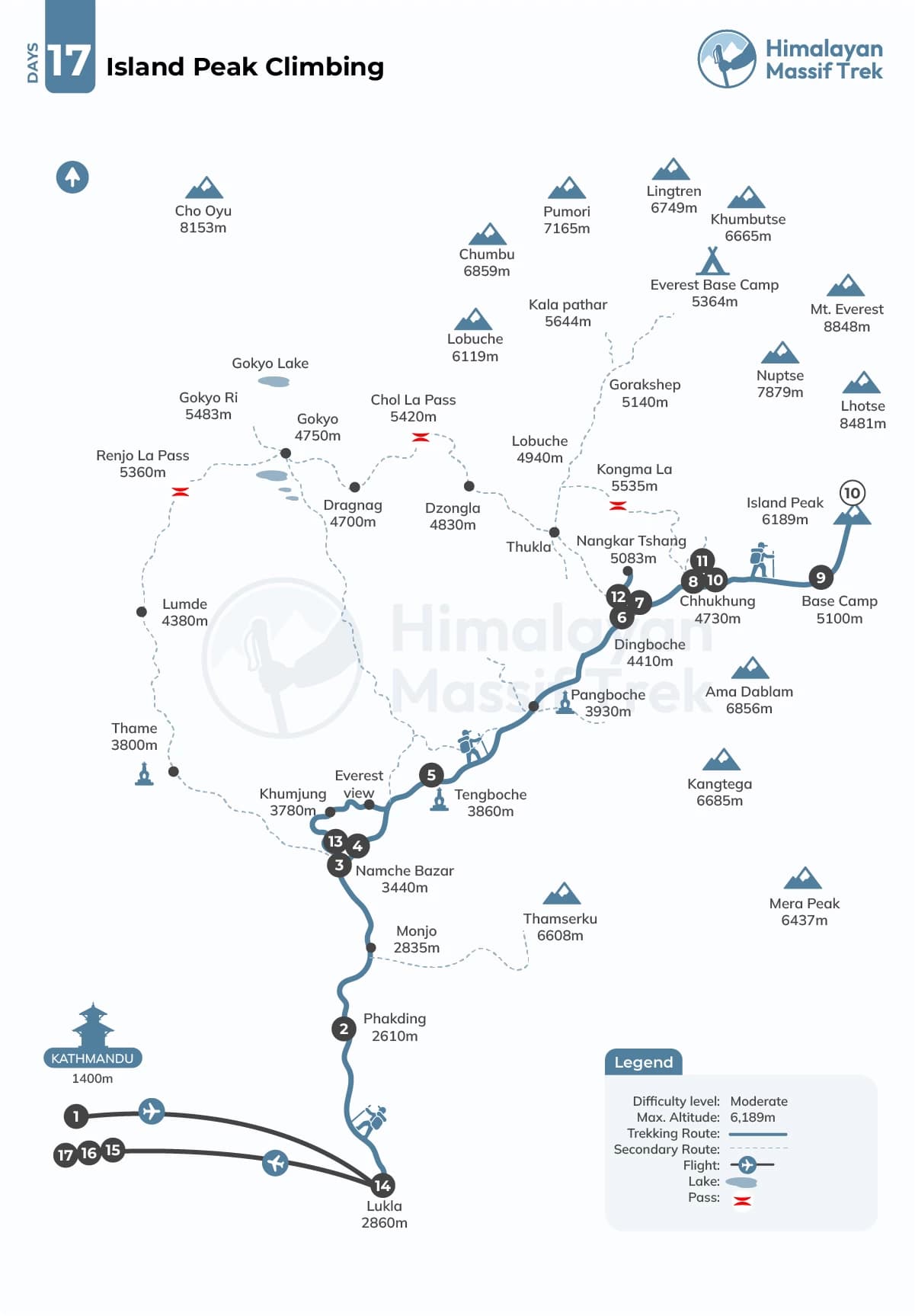

Cost Details
Transport and flights:
- Airport pick up and drop
- All ground and domestic air transfers for the trip
- Domestic flight to Lukla and return to Kathmandu ( Flights will operate from Ramcehhap during April, May, October and November)
Accommodation:
- 3-Star Accommodation in Kathmandu for 3 nights
- Teahouse Accommodation during the trek to Chhukung
- Tented camps accommodation during the climbing
Meals:
- 3-Standard meals each day
- Set of Breakfast, Lunch, and Dinner
Permit:
- Climbing permits, trekking permits, National park permits
Guide and porters:
- Certified and qualified English-speaking trekking/
- climbing guide (with a supporting crew of assistants and porters)
- One porter between two climbers
Equipment:
- Duffel Bag, Down Jacket, Sleeping Bag, Tent, Ropes and Harness
- First Aid kit
Miscellaneous:
- Compensation, meals, accommodation, and insurance for the guide and supporting crew
- Communication equipment, and medical evacuation coordination
- 24-hour administrative and online support to monitor the trip conditions, prepare for emergencies, and contact insurance companies
- Nepal Visa Fee
- International Airfare
- Lunch and Dinner in Kathmandu
- Rescue & travel insurance, trip cancellation costs, accident or health emergency, evacuation, loss, theft, or damage to baggage
- Extra night accommodation in Kathmandu due to any reason
- Personal expenses (phone calls, internet, laundry, bar bills, battery recharge, extra porters, cold drinks, bottled or boiled water, hot shower, etc.)
- All alcoholic and non-alcoholic beverages
- Tipping for Guides and Porters
- Personal clothing and other climbing gear not mentioned in the includes section
To confirm your payment, a deposit payment is required, which is 30% of the total booking price. This deposit helps us secure permits, logistics, and other necessary arrangements for your trek.
We understand that plans can change, and we strive to be as flexible as possible. However, to cover operational costs, a cancellation fee applies. This is a percentage of your total booking price and is deducted from the deposit payment.
Cancellation Fees
Cancel 30% days before departure: 5% of the trip cost
Cancel between 10 to 30 days before departure: 10% of the trip cost
Cancel within 10 days of departure: 20% of the trip cost
If you need to cancel, please notify us as early as possible to reduce charges.
Rescheduling
Unexpected circumstances can disrupt travel plans, even if you still want to do the trip. To support our clients, we have generously waived all rescheduling fees. You can postpone and reschedule your trip at no additional cost, as long as the new departure date falls within one year of your original booking.
Upgrades
If you wish to upgrade your accommodation, transportation, or any other services not mentioned in the Trip Includes section, please be aware that these upgrades will incur additional costs. We can assist in arranging these options for you based on your preferences and availability.
Lukla Flights
Non-Refundable Flight Ticket: If you need helicopter evacuation or other means of transport due to altitude sickness or any other condition, your return flight ticket fare is non-refundable.
Refundable Flight Ticket: If the flight operator cancels your flight due to bad weather in Lukla, Kathmandu, or any other reason, your flight ticket fare is 100% refundable.
Dates & Availability
Private TripIf you don't find an appropriate date, you can propose a Preferred Departure Date, and we’ll ensure the trip runs as scheduled just for you.
Trip Gallery
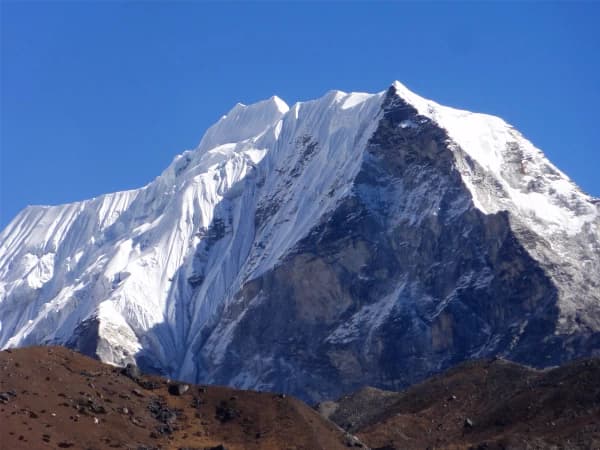
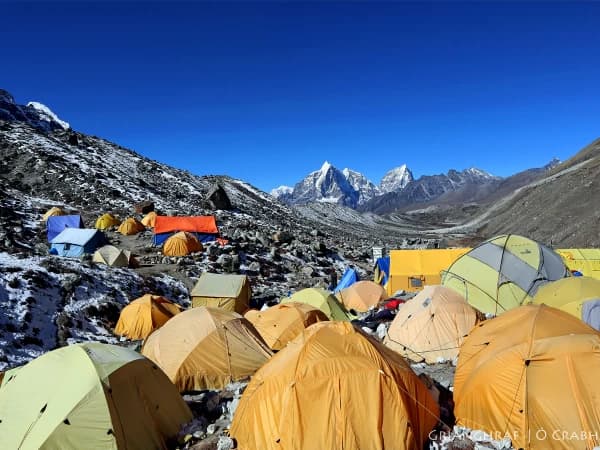

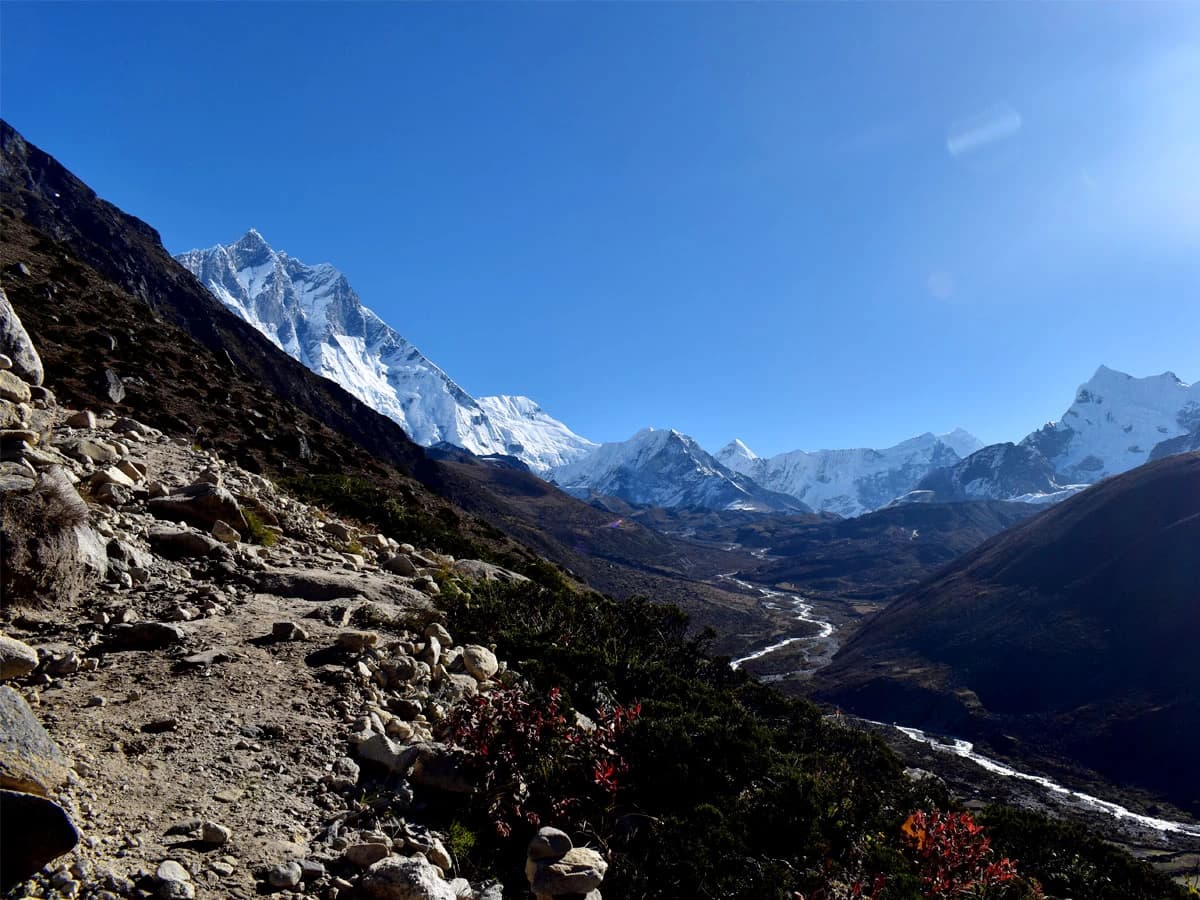
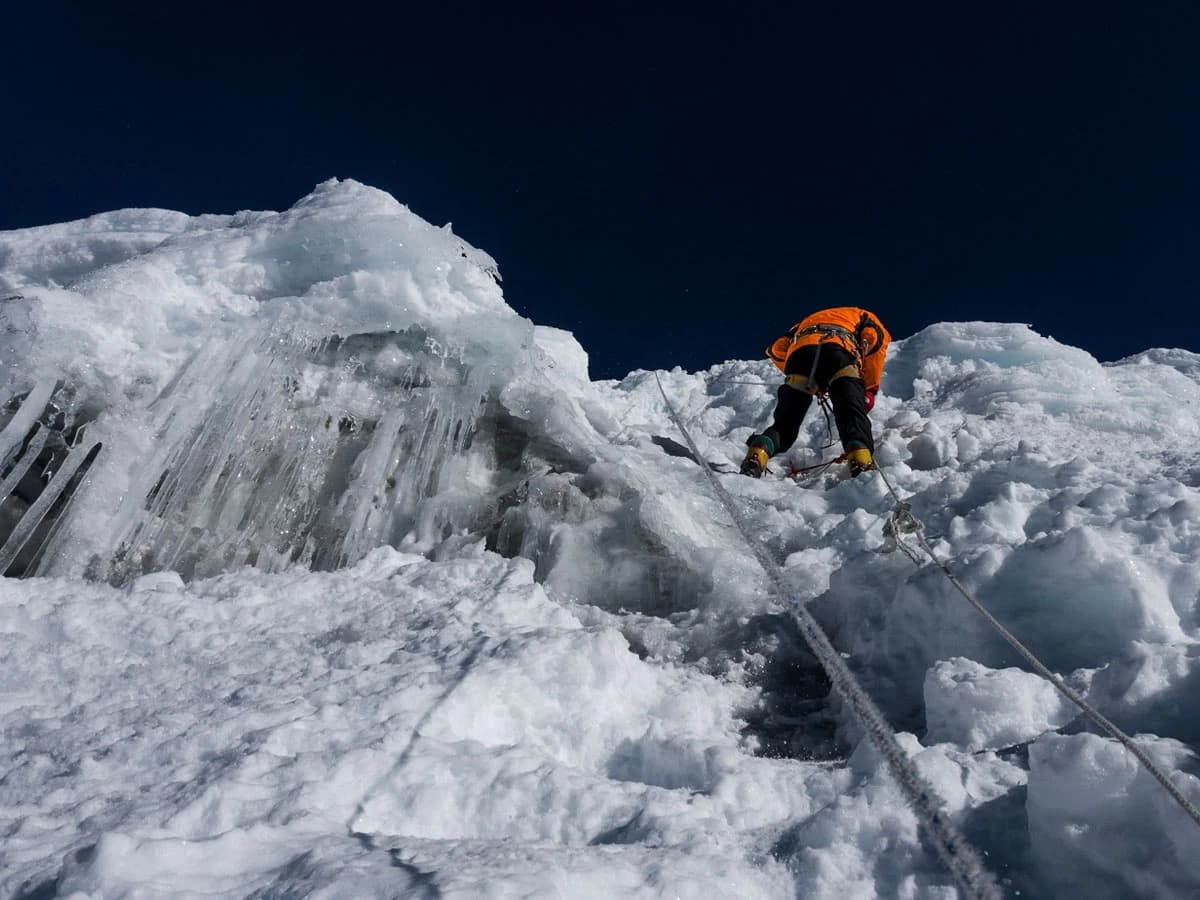
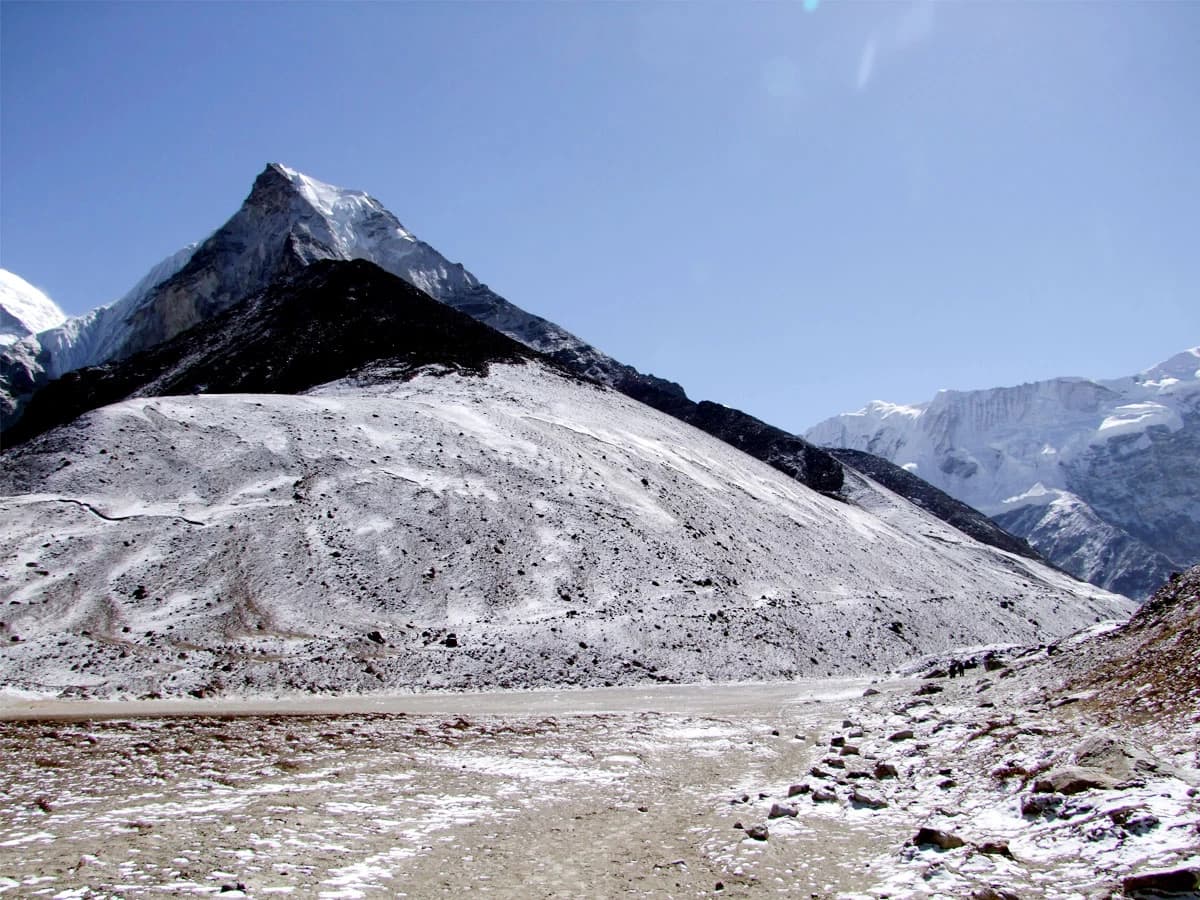
Essential Information
Best Time for Imja Tse Summitting Trip
Choosing the right time for Island Peak Climbing makes the journey more enjoyable and increases your chances of reaching the summit. While you can climb Island Peak throughout the year, spring and autumn are the best seasons for a successful and memorable adventure.
Spring (March to May) - Spring is a great time for the Island Peak Climbing Trip, offering clear skies, mild temperatures, and beautiful scenery. The trails are filled with blooming rhododendrons, green forests, and colorful meadows. The weather is warm, with daytime temperatures ranging from 15 to 17°C, while nighttime temperatures above 4,000 meters can drop to -10°C.
Autumn (September to November) - Autumn is another excellent season for Island Peak Climbing in Nepal due to its dry and stable weather. Since it follows the monsoon, the skies are usually clear, offering spectacular views of the Himalayas. Temperatures range from 0 to 15°C during the day, though by late November, nighttime temperatures can drop to -15°C.
Summer and Winter Challenges - The summer monsoon (June to August) is not ideal due to heavy rainfall, muddy trails, and the risk of landslides and avalanches. Similarly, winter (December to February) is cold, but with the right preparation and a skilled team, summiting Island Peak is possible. December is the best winter month for those who prefer quiet trails and peaceful surroundings.
Why pick the right time for Island Peak Climbing?
- To enjoy breathtaking views of towering mountains, including Mount Everest.
- To have a smooth Island Peak Climbing Trip without weather challenges.
- To walk through beautiful forests filled with blooming rhododendrons and wildflowers.
- To reduce the risk of altitude sickness.
- To keep the difficulty at a manageable level while making your Island Peak Summiting Trip enjoyable.
- To safely reach the summit while taking in the amazing scenery along dry and stable trails.
Accommodation during the Climb Imja Tse Package
In Kathmandu, you will stay in a 3-star hotel, providing a comfortable and relaxing stay before and after your adventure. Below are the types of accommodations you will experience during your Island Peak Climbing Trip.
Additionally, it is important to book early, especially during peak seasons, as the high number of trekkers can make it difficult to secure rooms. Early booking also helps you get better prices and avoid last-minute hassles.
Tea Houses
During your Island Peak Climbing Trip, teahouses are the most common accommodations along the trekking route. These small, locally run lodges offer basic but comfortable rooms with twin-sharing beds, blankets, and pillows. Some teahouses also provide hot showers, Wi-Fi, and charging facilities for an extra fee.
Meals are served in a communal dining area, where trekkers can relax and meet fellow adventurers. Since teahouses fill up quickly in peak seasons, it’s best to book in advance. In rare cases, trekkers may need to sleep in the dining hall if rooms are unavailable.
Tented Camps
Before reaching the summit of Island Peak, you will stay in a tented camp at Base Camp. Our expert team will set up tents and provide warm meals, ensuring a comfortable night before the climb. This is also where you will receive training on climbing equipment, helping you prepare for the final push to summit Island Peak. While camping is less common due to the availability of teahouses, it adds a sense of adventure for those who enjoy a more rugged experience.
Luxury Lodges
For those who prefer extra comfort, luxury lodges are available in larger villages along the Island Peak Climbing Package route. These lodges offer private rooms with attached bathrooms, hot showers, and heated blankets. Some even provide Wi-Fi, Western meals, and cozy lounges where trekkers can unwind and enjoy gorgeous views of the Everest region. While these lodges are more expensive than teahouses, they offer a premium experience for those looking for a more relaxing stay.
What to expect for meals during the Climb Imja Tse Package
Himalayan Massif Trek offers all three meals - breakfast, lunch, and dinner - except for in Kathmandu, where you can explore a variety of dining options. During your Island Peak Climbing in Nepal, you’ll enjoy delicious and nutritious meals, including traditional Nepalese, Tibetan, and Western dishes.
While meals after Namche Bazaar become more limited, you'll still enjoy well-known dishes like noodles, dumplings, flatbreads, and the staple Dal-Bhat-Tarkari (lentils, rice, and vegetables). Freshly cooked meals will be provided, even in tented camps before your climb. Throughout your Island Peak Climbing Trip, you'll find bread, sausages, butter, and hot drinks at every stop.
You’ll also get to enjoy Dal Bhat at every teahouse, and with improved infrastructure, some even offer fresh pastries and dishes made with Himalayan potatoes. For a better experience during your Island Peak Summiting Trip, focus on fresh vegetables, soups, and healthy options. Avoid drinking too much tea, coffee, or alcohol to make your trek easier.
Here’s a sample meal plan for your Island Peak Climbing Package:
Breakfast: Oatmeal, Cornflakes, Porridge, Eggs, Pancakes, Toast with Jam, Butter, Cheese, Honey, Tibetan Bread or Chapati, Fruit, Hot Drinks (Tea, Coffee, Milk)
Lunch: Nepalese Dal Bhat, Soups, Tibetan Bread, Sherpa Stew, Steaks, Thukpa (Noodle Soup), Pasta, Sandwiches, Momo (Dumplings), Tenduk Noodles, Potato Dishes, Desserts
Dinner: Nepalese Dal Bhat, Soups, Tibetan Bread, Thukpa, Tenduk Noodles, Pasta, Salads, Potato Dishes, Desserts
Drinking Water during the Imja Tse Climbing Package
Staying hydrated is essential during your Imja Tse Climbing Trip. However, it’s important to be careful with the water you drink. While water can be found from streams and taps along the route, it may not always be safe. To stay safe, you should either boil the water, filter it, or use purification tablets.
On your Imja Tse Climbing Package, most lodges provide safe drinking water for a small fee. You can also bring your own purification system for convenience. While bottled water is available, it’s costly and contributes to plastic waste. We recommend carrying a reusable water bottle or camel bag to refill as you go.
During the Imja Tse Summitting Trip, our team will help by providing cold water and purification tablets. You can refill your bottles at lodges or meal stops, but keep in mind that mineral water will come with an additional cost. Drinking plenty of water throughout your Imja Tse Climbing Package will help keep you energized and prevent dehydration, making your trek safer and more enjoyable.
Island Peak Climbing Package Difficulty
Island Peak Climbing is a challenging yet rewarding adventure, especially for those with prior high-altitude trekking experience. The trek to base camp follows typical Everest region routes, requiring 5-6 hours of walking daily.
However, the climb itself involves steep sections, including fixed ropes and crevasses, making it more technical than a regular trek. It's crucial to have basic climbing knowledge, like using a Jumar, but the hardest part is the final 100-meter ascent to the summit, which requires good physical fitness.
At 6,189 meters (20,305 feet), Island Peak presents significant altitude challenges. The thin air makes breathing more difficult and increases the risk of Acute Mountain Sickness (AMS). Therefore, proper acclimatization is key, along with using ice axes, crampons, and fixed ropes to safely navigate glaciers and steep ridges. Summit day can take 10-12 hours, and the unpredictable weather adds extra difficulty, making good gear and preparation vital.
While Island Peak Climbing in Nepal is seen as an introduction to Himalayan mountaineering, it still requires mental resilience, especially when facing the summit ridge and headwall. Novice climbers can succeed with the help of experienced Sherpas and training, making it a challenging but achievable goal for those ready for the adventure.
Altitude Sickness and Remedies on Climb Island Peak Package
Altitude sickness is a common challenge during Island Peak Climbing, caused by lower oxygen levels at higher altitudes. Symptoms like headaches, nausea, dizziness, and fatigue can appear if the body doesn’t adjust properly. To prevent this, it’s important to ascend gradually, stay hydrated, eat nutritious meals, and avoid alcohol and tobacco. Taking rest days and following the "climb high, sleep low" strategy can also help with acclimatization.
If mild symptoms occur, resting at the same altitude, drinking warm fluids, and taking pain relievers can help. In severe cases, where symptoms worsen or include vomiting, confusion, or difficulty breathing, the best remedy is to descend immediately. Oxygen therapy and medications like Diamox (acetazolamide) can assist but should be used under medical guidance. Having an experienced guide is crucial, as they can monitor your condition and take necessary actions.
Proper preparation before your Island Peak Climbing Trip can significantly reduce risks. Consulting a doctor before the climb, staying informed about emergency procedures, and carrying essential first-aid supplies are all important steps. Local remedies, such as garlic soup and ginger tea, may also help with altitude adjustment. By listening to your body and following the right precautions, you can safely summit Island Peak and enjoy a rewarding experience.
Requirements of Travel Insurance for Island Peak Summitting Trip
Having travel insurance is important for Island Peak Climbing in Nepal. Since the climb involves high altitudes and remote areas, your insurance should cover emergency medical evacuation, including helicopter rescue, in case of serious illness or injury. It should also include medical expenses, trip cancellations, and coverage for mountaineering activities to ensure full protection throughout the journey.
When choosing a policy, make sure it covers altitudes up to 6,500 meters and includes treatment for altitude sickness or injuries. A good policy should also provide repatriation coverage, which helps in case you need to return home due to a medical emergency. Additionally, check for trip cancellation coverage in case of unexpected weather, political issues, or personal emergencies.
Before purchasing insurance, read the policy carefully to ensure it includes everything you need. Look for a reputable provider that specializes in high-altitude travel. If you have pre-existing medical conditions, confirm they are covered. With the right insurance, you can climb Island Peak with peace of mind, knowing you are well-prepared for any situation.
Permits to do Island Peak Climbing Trip
Before starting your Island Peak Climbing Trip, you need a few important permits. These permits help protect the environment, support local communities, and ensure safety during your climb. If you book with us, we will arrange all permits, documents, and their respective fees for you:
Sagarmatha National Park Permit – Required to enter the Everest region, this permit helps with conservation efforts. It costs NPR 3,000 (~21 USD) for foreign nationals and NPR 1,500 (~11 USD) for SAARC nationals. You can get this permit from the Nepal Tourism Board Office in Kathmandu or at the Sagarmatha National Park Entry Gate in Monjo.
Khumbu Pasang Lhamu Rural Municipality Permit – Issued by the local government, this permit costs NPR 2,000 (~20 USD) per person. You can get this at the Sagarmatha National Park Entry Gate in Monjo. Please remember there are no alternative offices in Kathmandu that issue this permit.
Island Peak Climbing Permit – Required to summit Island Peak, this permit is issued by the Nepal Mountaineering Association (NMA) in Kathmandu. The cost varies by season:
March to May: $250 (~NPR 35,000) per person
September to November: $125 (~NPR 17,500) per person
June to August & December to February: $70 (~NPR 10,000) per person
TIMS (Trekkers' Information Management System) Card – Issued by the Nepal Tourism Board, it helps track trekkers for safety and emergency support. The TIMS card costs NPR 2,000 (~14 USD) for non-SAARC trekkers and NPR 1,000 (~7 USD) for SAARC nationals. You can get a TIMS card in Nepal from the Nepal Tourism Board (NTB) offices in Kathmandu and Pokhara, or the TAAN Secretariat in Kathmandu. You can also get a TIMS card from the TIMS checkpost in Pokhara.
Island Peak Climbing Equipment List
FAQs
Island Peak is considered a moderately difficult climb, but it does not require advanced technical skills. While previous climbing experience is not necessary, you should be physically and mentally prepared. We recommend engaging in activities like hiking, jogging, cycling, or swimming before the trek to build strength and endurance.
Summit Day presents several challenges, including long physical exertion, technical sections that require ropes and ice axes, and the high-altitude environment. The final push from High Camp is steep and demanding. Weather can also be unpredictable, with strong winds and cold temperatures. To overcome these challenges, proper acclimatization, physical preparation, and mental strength are essential.
Previous climbing experience is not required, but having some basic mountaineering skills and experience with high-altitude trekking is highly recommended. This will help make your climb safer and more enjoyable.
The risk of avalanches on Island Peak is low, but it can increase after heavy snowfall or in warmer weather. Our experienced guide will regularly assess the conditions and take precautions. It's important to follow their instructions and avoid unnecessary risks.
Climbing Island Peak is challenging, but beginners can attempt it with proper preparation. The high altitude makes breathing difficult, so acclimatization, staying hydrated, and eating well are important. The final steep climb is the hardest part, especially after several hours of trekking. Prior high-altitude trekking, like the Everest Base Camp Trek, and strength training can help you handle the climb better.
Various factors can affect your Island Peak climb, such as altitude sickness, weather, and individual fitness. However, we carefully select dates when the conditions are most favorable for your trek and climb. As a result, the success rate for Summiting Island Peak typically ranges from 70-85%.
Weather, fitness, acclimatization, and preparation all play important roles. Plus, climbers who stick to the itinerary, prepare properly, and are guided by professionals have a higher chance of reaching the summit. Success also depends on how well the group handles the physical and mental challenges of high altitudes.
You will climb with other like-minded people unless you book a private tour or there’s no group on your chosen date. Your guide will be an experienced local climbing instructor or Sherpa who has summited Island Peak many times. Some guides have also summited Mt. Everest. They will provide climbing tips and pre-summit training at base camp. Make sure to choose a reputable operator for your safety.
Yes, your trip is guaranteed to run. We always operate our booked trips, even if other trekkers cancel. Unlike some agencies that may cancel trips last minute, we ensure your trek goes ahead as planned. As a tailor-made company, the number of participants doesn't affect our trips. If your trip is canceled by another operator, feel free to reach out to us for a smooth, stress-free solution. Our trips are 100% guaranteed unless an uncontrollable situation, like a natural disaster, political unrest, or severe weather, arises.
For climbing Island Peak, you will need mountaineering boots, crampons, an ice axe, a climbing harness, a helmet, warm clothing layers, gloves, and other essential climbing gear. Having the right equipment is crucial for a safe and successful climb.
Yes, you can rent climbing gear in Nepal. Kathmandu and Lukla have many rental shops. However, it's a good idea to bring your gear and only rent the equipment you don't have or can't bring with you.
Wearing the right clothing is very vital for the Island Peak climb. Layering properly will help keep you warm, especially during cold nights when temperatures can drop to -10 to -15°C. We recommend choosing high-quality gear and clothing to ensure comfort and protection from the cold.
To prepare for Island Peak climbing, focus on building strength, stamina, and getting used to higher altitudes. Cardiovascular exercises like running, hiking, and cycling are important, along with strength training for your legs, core, and upper body. Hiking with a loaded backpack and practicing climbing on smaller peaks or ice walls will also help. The key is to improve your cardiovascular endurance to handle the high altitude.
The summit day of Island Peak usually takes about 10-12 hours. Climbers start early, around 2-3 a.m., to reach the summit before the afternoon winds pick up. The climb includes a steep glacier and rock section, followed by a fixed-rope section. After reaching the summit, the descent to base camp takes about 4-5 hours.
Island Peak stands at an altitude of 6,165 meters (20,226 feet) above sea level.
Island Peak is in the Khumbu region of northeastern Nepal, near Mt. Everest and Lhotse. It lies within Sagarmatha National Park, a protected area known for its stunning mountain landscapes and rich biodiversity.
If you show signs of altitude sickness, the first step is to descend to a lower altitude for recovery. Our guides are trained to handle these situations, and if needed, they will arrange medical evacuation. Make sure to leave a copy of your travel insurance at our Kathmandu office, so our team can assist with any necessary arrangements. Our Sherpa and crew will take care of you while waiting for help.
Yes, you need a climbing permit for Island Peak. You can get it through a registered trekking agency like us in Nepal. The cost of the permit varies based on the season and your nationality.
Communication services are limited in the Island Peak region. While signals are not widely available, you may get some telecommunication coverage at the base camp if the weather is clear.
Knowledgeable Local Team: Our skilled local team knows the Khumbu region well, ensuring your Island Peak Climbing in Nepal is safe and memorable. Whether you’re on the Island Peak Summitting Trip or combining it with the Everest Base Camp trek, our team will guide you through the trails while sharing insights about the culture, landscapes, and mountain routes.
Cultural Connection: During your journey, you’ll visit Sherpa villages like Tengboche, Dingboche, and Gorakshep. You’ll enjoy local meals, experience Sherpa hospitality, and learn about their traditions. This makes your Island Peak Climbing Package not just an adventure but also a cultural experience.
Best Value for Your Adventure: We offer fair pricing with no hidden costs. Your climb Island Peak Package includes permits, comfortable stays, and delicious meals. Plus, we provide discounts for groups and returning travelers, making your Imja Tse Climbing Trip even more worthwhile.
Responsible Trekking: We follow eco-friendly trekking practices and support local communities. Choosing us for your Climb Imja Tse Package means helping to preserve the Himalayas for future generations while enjoying a sustainable travel experience.
- Expertise in High-Altitude Trekking Adventures
- Over 18 Years of Experience in The Himalayas
- Authorized and Reliable Trekking Partner
- Trusted by Thousands of Adventurers Worldwide

Climbing Island Peak with Himalayan Massif Trek was one of the most challenging and rewarding things I’ve ever done! I’m still on a high from...
I’ve just come back from climbing Island Peak, and I still can’t believe I made it to the top! The journey was intense, but the...


